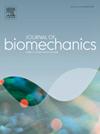Propulsive and braking contribution of the lower limbs, trunk, and upper limbs during underwater undulatory swimming calculated from vortices distribution: A simulation study
IF 2.4
3区 医学
Q3 BIOPHYSICS
引用次数: 0
Abstract
Swimmers propel their bodies forward by generating vortices around themselves, which produce fluid force during underwater undulatory swimming (UUS). This study aimed to investigate the propulsive and braking contributions of the vortices of the lower limbs, trunk, and upper limbs during UUS. The kinematic data and three-dimensional digital model were collected from nine male swimmers. Vortex generation was obtained using computational fluid dynamics, and the fluid force of six vortices was determined from the vortex circulation, swimmers' segment velocity, and length. Foot vortices contributed 96.7 % to producing braking fluid force during the first half of the downward kick. Vortices of the feet and the ventral side of the trunk contributed 69.3 % and 58.8 % to producing the propulsive fluid force during the last half of the downward kick, respectively. During the first half of the upward kick, the vortices of the feet and ventral side of the trunk contributed to producing the 87.3 % of propulsive and 93.3 % of braking fluid force, respectively. During the last half of the upward kick, 63.1 % of propulsive and 86.9% of braking fluid forces were produced by vortices on the ventral side of the trunk and feet, respectively. Small fluid forces and contributions were detected for vortices of the arms, lower legs, dorsal sides of the shoulders, and waist. These results indicate that the vortices of the feet and ventral side of the trunk mainly contribute to the increase and decrease in the horizontal UUS velocity.
求助全文
约1分钟内获得全文
求助全文
来源期刊

Journal of biomechanics
生物-工程:生物医学
CiteScore
5.10
自引率
4.20%
发文量
345
审稿时长
1 months
期刊介绍:
The Journal of Biomechanics publishes reports of original and substantial findings using the principles of mechanics to explore biological problems. Analytical, as well as experimental papers may be submitted, and the journal accepts original articles, surveys and perspective articles (usually by Editorial invitation only), book reviews and letters to the Editor. The criteria for acceptance of manuscripts include excellence, novelty, significance, clarity, conciseness and interest to the readership.
Papers published in the journal may cover a wide range of topics in biomechanics, including, but not limited to:
-Fundamental Topics - Biomechanics of the musculoskeletal, cardiovascular, and respiratory systems, mechanics of hard and soft tissues, biofluid mechanics, mechanics of prostheses and implant-tissue interfaces, mechanics of cells.
-Cardiovascular and Respiratory Biomechanics - Mechanics of blood-flow, air-flow, mechanics of the soft tissues, flow-tissue or flow-prosthesis interactions.
-Cell Biomechanics - Biomechanic analyses of cells, membranes and sub-cellular structures; the relationship of the mechanical environment to cell and tissue response.
-Dental Biomechanics - Design and analysis of dental tissues and prostheses, mechanics of chewing.
-Functional Tissue Engineering - The role of biomechanical factors in engineered tissue replacements and regenerative medicine.
-Injury Biomechanics - Mechanics of impact and trauma, dynamics of man-machine interaction.
-Molecular Biomechanics - Mechanical analyses of biomolecules.
-Orthopedic Biomechanics - Mechanics of fracture and fracture fixation, mechanics of implants and implant fixation, mechanics of bones and joints, wear of natural and artificial joints.
-Rehabilitation Biomechanics - Analyses of gait, mechanics of prosthetics and orthotics.
-Sports Biomechanics - Mechanical analyses of sports performance.
 求助内容:
求助内容: 应助结果提醒方式:
应助结果提醒方式:


